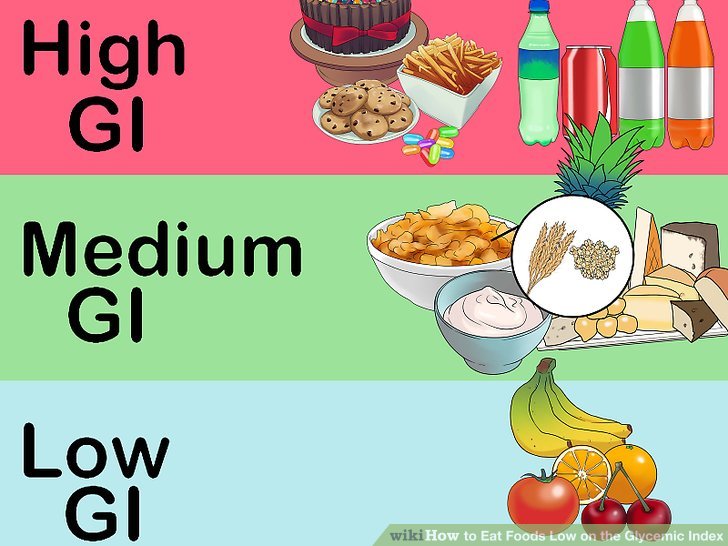Glycemic index and harmful effects.
April 03 ,2018 in Glycemic index
How High Glycemic Index Foods Impact Your Health
High GI carbs such as Sugars, Refined Starches
- Are quickly absorbed by the organism
- Dramatically increase glycemia
- Provide ephemeral satiety.
- Are a readily available but quickly exhaustible source of energy
A GI of 70 or more=high, a GI of 56 to 69 inclusive=medium, and a GI of 55 or less=low.
> 70 is HIGH
< 55 is LOW
Glycemic load:
The total carbohydrate content of food. The GL gives a numerical value indicating how a serving of food affects blood sugar, it multiplies the amount of carbohydrates found in a serving of food with that food’s GI and divides that number by 100. For example watermelon has a high GI (72), but the amount of carbs in a serving of watermelon is low, so it has a low GL (4)
High Glycemic Impact Foods and Inflammation.
Inflammation is the normal and desired way our body responds to injuries. There are two types of inflammation: acute and chronic, also known as silent inflammation. An example of acute inflammation is a toothache or a skin cut. The characteristics of it are swelling, pain, redness and heat.
Chronic inflammation is not easy to identify (hence the name silent), because it is below the threshold for pain. Silent inflammation is the inflammation we are all concerned about as is at the root cause of most chronic degenerative conditions. This is the inflammation that can be reduced or aggravated by lifestyle factors, including FOOD.High-glycemic index foods fuel the production of advanced glycation end (AGE) products that stimulate inflammation.
Eating foods with low glycemic load, lowers inflammatory markers and helps you feel fuller for longer.
- According to Harvard researchers, healthy, middle-aged women who ate the meals with the lowest glycemic load had the lowest levels of C-reactive protein, a marker of inflammation in the body.
- In overweight women who had greater levels of C-reactive protein to begin with, eating higher amounts of low glycemic index foods had an even greater impact on their inflammatory markers.
Over time consumption of high GI and GL foods can lead to insulin resistance, which translates into glucose not being effectively cleared from the blood after eating. This extra glucose and extra insulin in the bloodstream causes inflammation.
High GI and Heart Disease
- According to research in the May 2009 issue of the American Journal of Clinical Nutrition, long-term intake of grains with different glycemic indexes may affect the extent of inflammation in people with the heart disease risk factors. For example, researchers from Finland found that the glycemic response to rye bread and pasta are lower than that of oat, wheat bread and potato – with the harmful effects of high blood sugar sticking around in the body for more than two hours. The people involved in this study had metabolic syndrome, which means they were already at higher risk of developing heart disease and other inflammatory conditions.
- Numerous studies have shown that overweight adults on low-GI diets have lower levels of CRP and lower blood levels of bad LDL cholesterol than their overweight peers who eat high-GI diets – even if they didn’t lose weight on the low-GI diet.
High GI and Type 2 Diabetes
- When it comes to managing weight, blood sugar and inflammation, portion control of carbohydrates – even low-GI/GL carbs – means you’re not only eating a low Glycemic Impact diet, but a lower carbohydrate diet also.
- Another study from Harvard showed that diets high in low-GI whole grains and portion-controlled carbohydrates may have a protective effect against systemic inflammation in diabetic patients.
- In a 2007 report, long-term, epidemiological studies were reviewed and reached the conclusion that low-GI diets reduce oxidative stress and guard against system-wide inflammation that may mark the beginnings of type 2 diabetes.
Glycemic Response and Colonic Health
- We couldn’t talk about carbohydrates, inflammation, weight…, and not talk about gut health, as this is one of my core focuses: “heal the gut to heal the body”! Without going into the details to why that is, let’s have a look at the gut and high GI/GL diet.
- The colon (AKA large intestine) is a highly active metabolic organ, containing an exceedingly complex society of microbes. The strength of the gut, is determined in part by the rate of colonic fermentation. In simpler terms the microbes present in the large intestine are responsible for breaking down the fiber, the non-digestible (by humans) parts of plants, or complex carbohydrates. This fermentation results in the production of several gases and SCFA (short chain fatty acids) which have several physiological and pathophysiological effects in the body. The colonic fermentation appears to be affected by the rise and fall of blood sugar levels after eating high-GI foods.
- In comparing a high-GI meal to a low-GI meal, Swedish researchers found that rates of colonic fermentation (again a sign of a healthy gut) dropped as blood sugar levels peaked.
- In this study, 15 healthy people ate evening meals with varying amounts of non-digestible fiber (the kind found in wheat bran). At breakfast, those who ate more non-digestible, low-GI carbs reported increased feelings of fullness and showed higher rates of colon fermentation.
Reference:
https://www.mihaelatelecan.com/how-high-glycemic-index-foods-impact-your-health/







